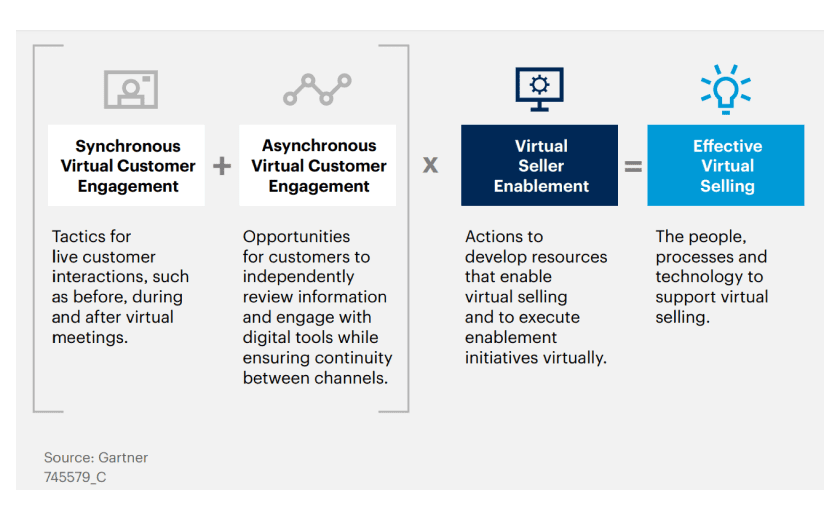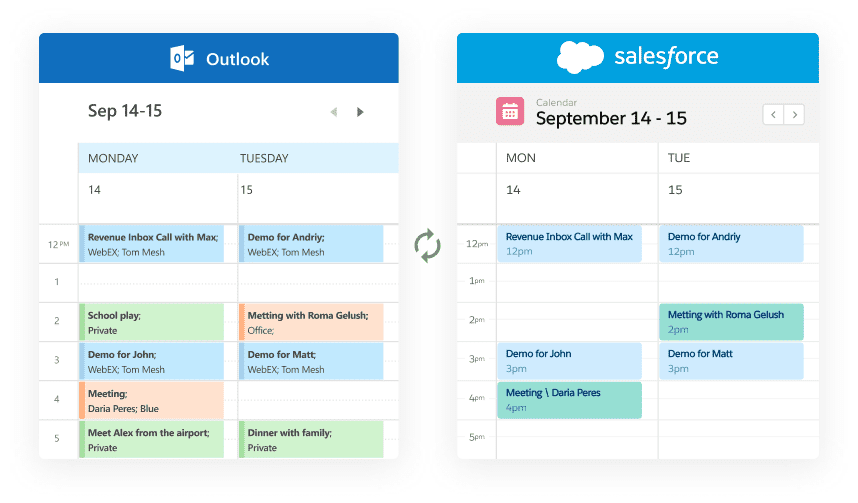Virtual selling isn’t a product of the pandemic era. It’s been around for years.
It’s just that it blew up when COVID came on the scene – forcing sales organizations around the world to go virtual – or shut their doors and go home.
And while many thought virtual selling was a temporary fix – it didn’t take long for sales leaders to figure out that nurturing leads and closing deals in cyberspace came with some serious advantages.
But – it’s important to note that there’s a big difference between using technology during the sales process and actually building a future-proof virtual sales strategy.
And spoiler: unlocking any of its potential advantages requires strategic planning, training, and implementation.
Read on and I’ll explain what all this means – and what it takes to succeed in a virtual selling environment.
What is Virtual Selling?
Virtual selling is an umbrella term for the collection of technologies and processes sales reps use to engage buyers remotely. The term applies to any part of the sales process where analog or face-to-face activities have been replaced with digital technologies – and spans both synchronous and asynchronous communications.
The most obvious example of virtual selling is conducting sales meetings via Zoom instead of traveling to meet the buyer in person.
But – virtual sales tactics go way beyond replacing everything with Zoom. Rather, it’s about finding new ways to enhance your sales process with digital elements to get the right results at each touchpoint.
I’ll discuss this more in the next section, but virtual selling spans a wide range of technologies and tactics and it’s more about using the right tools and the right skills in context than any specific type of technology.
Virtual Selling Best Practices
We’ll go over some virtual sales techniques – plus some ways to create the right environment for success.
Redesign your sales process with virtual in mind
Sales leaders need a clear plan for supporting reps in a virtual environment.
Gartner’s framework for enabling effective virtual selling (pictured below) does a nice job distilling effective virtual sales strategy into three core components:
- Synchronous engagement. Virtual selling tactics for via live interactions with buyers. Think — guided product tours, presentations, and yes, Zoom meetings. Here, your goal is translating sales tactics from the face-to-face world like asking probing questions, identifying pain points, objection handling, and so on to a digital format. You’ll need to account for things like body language and delayed facial expressions. It’s also harder to capture and sustain peoples’ attention on-screen — making it more difficult to build rapport and foster lasting connections.
- Asynchronous engagement. Content and materials buyers can review on their own using digital tools. Virtual selling examples include self-service portals, online communities, social media posts, blog content, etc. Here, the focus is on providing a consistent customer experience spanning all channels. The challenge becomes more about delivering the right message to the right person at the right time, rather than say, overcoming objections and closing.
- Virtual sales enablement. The actions, resources, and technology needed to ensure that sales reps have everything they need to deliver a top-tier virtual sales experience. Like “regular” sales enablement, the aim is making it easier for sellers to, well, sell.

Gartner analysts also emphasize the critical importance of building a strategy that fits in with your organization’s culture and aligns with your business model and your customers’ expectations.
So, it’s not just embracing new tools and processes because your competitors are — it’s about strategically combining the right tools and techniques for engaging your buyers.
Embrace content as a closer
According to a RAIN Sales Training report on virtual selling, 34% of buyers feel that reps can effectively explain how to solve a problem or show them the possibilities offered by their solution. Worse, just 16% of those respondents say that reps are “very effective” at connecting their solution to buyer ROI when selling in a virtual environment.
Sure, those numbers indicate a need for better training programs. But they also highlight the essential gap that content fills in an all-virtual sales landscape.
Another report from Bain & Company says that a big part of winning in a virtual environment is winning the deal before it gets to the rep. Analysts found that close to 80% of B2B buyers have already defined their requirements before talking to a rep and prefer evaluating digital resources to in-person presentations.
Sales and marketing teams must work together to develop better content. For example, marketers can use material sourced from sellers — video explainers that break down specific features, anecdotes from the field, relevant sales data.
That said, marketers need to develop a better understanding of the sales process — and the individual steps and touchpoints where content supports the buying process. That way, they can create messaging that better speaks to buyer needs at different points in their journey.
On the sales side, marketers need to provide sellers with context for each piece of content. How, when, why should content be used? How should it be presented to buyers?
Keep in mind, it’s not just blog posts and downloads that do the heavy lifting. Consider embracing different types of content into the sales process — testimonials, virtual pitches, user-friendly demos, etc.
Additionally, personalized sales content goes a long way. According to McKinsey research, personalization is a revenue accelerator. On average, the fastest-growing companies generate 40% more of their revenue from personalized engagements than their slower-growing peers.
Make virtual sales techniques a priority in training
Don’t treat virtual selling as an afterthought. It’s not less important than in-person sales, it’s just another way to connect with buyers.
Virtual selling is selling – and as such, virtual selling skills should be a central part of your training and coaching programs.
For example, you’ll want to make sure to create training content that helps reps effectively prepare for virtual meetings. For new users, that means going over basic things that make meetings run more smoothly – like how to set agendas, send invites, and interpret a new set of non-verbal cues.
Your training program might also cover things like using video messages as part of your outreach strategy, prospecting on LinkedIn, and creating engaging, mixed reality sales presentations. It also might include traditional techniques how to make effective sales calls.
Ultimately, your virtual training program should be informed by your existing sales processes, target audience, and the tools in your stack.
Virtual Selling Tools
Virtual selling tools aren’t confined to a specific category.
They can include anything from the trusty CRM and sales enablement platforms to digital basics like Google Workspace, Zoom, or even Outlook – anything that helps your sales team is successful in a virtual environment.
I’ve included a few tools that enhance the virtual sales experience from different angles.
And while this only represents a small fraction of what’s out there, this is a good jumping-off point for doing your own research.
- Revenue Grid. Revenue Grid is a revenue intelligence & customer engagement platform designed to help sales organizations capture and unify sales data, guide reps through the sales process, and provide full visibility into the pipeline – and the activities and behaviors that move deals forward. The platform’s Revenue Signals feature allows sales leaders to automate playbooks and best practices – ensuring that reps take the right action whether they’re working remotely or meeting face-to-face. Revenue Grid’s automated data capture syncs data from your inbox and calendar back to customer records in Salesforce.

And – Sales Sequences help users follow up at the right time — with the right message — to keep deals moving forward without adding more top rep workloads.
- Khoros. Khoros is a customer engagement platform with a long list of features that help organizations optimize and orchestrate customer journeys – with some help from the built-in AI. Key use cases include conversational marketing, AI-powered virtual agents, and the ability to build user-generated knowledge hubs that educate and engage.
- Owler. Owler is a news monitoring platform that helps salespeople keep up with industry news and announcements. It’s an effective prospecting tool that allows users to set up alerts for key accounts when there’s a trigger event like an acquisition, an IPO, a product launch, or a successful round of funding. Reps can then use that information to inform their initial outreach efforts and present solutions with new challenges in mind.
- Vidyard. Vidyard’s video software allows you to record videos and screen captures from your phone or browser, manage & host your content, and share your message across a wide range of sales channels. The platform makes it easy to deploy videos throughout the entire sales process – outreach, engagement, education, onboarding, etc. You can stitch together custom playlists based on each buyer’s needs, role, or pain points, and dig into Vidyard’s built-in analytics to understand what’s working – or not.
- 6sense. 6sense unifies sales, marketing, and ops teams by identifying the best deals to focus on – and when – as well as the topics and pain points decision-makers, care about most. The platform’s predictive intelligence engine enables teams to forecast future behaviors – in context and leverage those insights to lock down big wins.
- Bombora. Bombora is another virtual sales tool that specializes in understanding buyer motivations and behaviors. The platform captures and analyzes data from a variety of sources to ID which prospects on your list are actively searching for your solutions. This tool allows you to learn more about how buyers navigate the “self-service” parts of your sales process and helps you identify decision-makers –and the content and messaging that compels them to take action.
- Demodesk. Demodesk is an intelligent sales meeting platform designed to support live coaching, hands-on demos, and other buyer interactions – and automate non-selling tasks that waste time. Unlike traditional video conferencing tools, Demodesk allows reps to collaborate directly with customers and not only share the screen – but share control, enabling browsing & editing on both sides. Additionally, the platform integrates natively with your CRM, connected apps/data sources, and your calendar.
- Gong. Gong is a conversational analytics platform that allows you to identify what’s working – or not – in your sales conversations. Gong leverages its built-in AI to record and transcribe sales calls, then analyzes the contents and serves up a list of time-stamped recommendations for helping reps boost their performance.
- Highspot. Highspot is a content management platform that uses AI and machine learning to serve up the right content at the right time, based on contextual clues. The platform syncs with Salesforce and allows users to gain real-time insights into how prospects and customers engage with content and communications — critical insights you can use to improve your messaging to drive better outcomes.
For more tech that can enhance the virtual sales experience, check out our previous post, 8 sales management tools to know.
Conclusion
Virtual selling can shorten sales cycles, boost win rates, and generate deeper insights about your customers.
But it’s not just about swapping in-person meetings for Zoom calls or spending more time on LinkedIn.
It’s about being thoughtful about using technology to improve the buyer experience, instead of creating a cheap imitation of a bygone sales strategy.